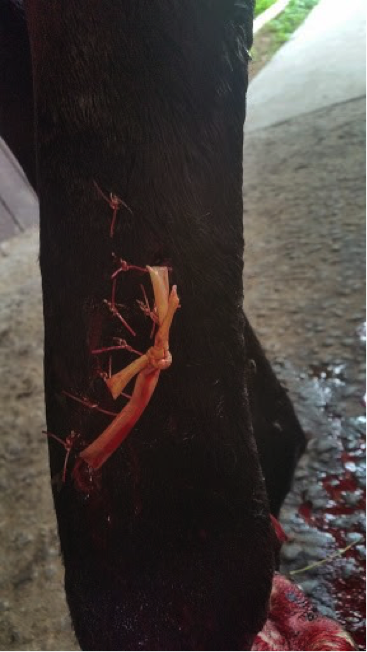Horse wounds often require vet treatment via suturing, bandaging or casting. Darling Downs Vets Westbrook Equine Unit is well equipped to handle major wound surgery.
Complications of wound healing and solutions.
In the last blog post we discussed first aid for horses with open wounds and those factors that enhance or slow down normal wound healing processes. In this article we will outline definitive repair of wounds by surgery and discuss complicated wounds and some potential solutions.
To stitch or not?
Ideally, every wound would be sutured, as skin edges that are held in close apposition via suturing will heal in the shortest length of time with a minimum of scarring. Wounds should be fresh and clean for optimum results (Fig 1). Unfortunately, suturing is not always possible and many wounds are left open to heal in a process called ‘second intention wound healing’.
It is sometimes necessary to surgically remove tissue and skin that no longer has an intact blood supply, however efforts should be made to save any skin that is viable (remember, we can’t grow more of it!).
Many horse owners have had experience of sutured wounds breaking open after a few days. This can occur due to many factors including tissue swelling and excessive movement of the repair site. Vets will often warn owners if they think this may occur. This effort of primary repair via surgery helps to reduce the eventual defect and gives an improved overall result even if the original stitch job does not hold.
Granulation tissue and proud flesh- too much of a good thing.
Granulation tissue begins to form from three to six days after injury and is an important stepping stone in the repair process. It provides a protective seal over the underlying tissues and hence prevents bacterial infection. It also acts as a bridge to allow epithelial cells to migrate over and it contains fibroblasts, which are the cells responsible for both production of collagen and wound contraction, all essential parts of the wound healing process.
Unfortunately, horses are the species ‘par excellence’ in forming excessive granulation tissue, commonly referred to as ‘proud flesh’. Granulation tissue is considered to be excessive (or ‘proud’) when it becomes raised above the level of the normal adjacent skin. Good wound repair practices as early as feasible, and pressure in the form of bandaging or casting will help to reduce the likelihood of proud flesh but sometimes it just cannot be avoided.
The best way to deal with proud flesh is to have it surgically removed by a vet, who will often trim it back level or to just below the level of the adjacent skin.
Other common treatment methods for proud flesh includes the use of astringent or caustic medications such as Ranvet Yellow Lotion or topical steroid ointments such as Prednoderm. Both of these approaches will likely be successful at dealing with the excessive granulation tissue but can be damaging to other components of the wound healing process.
Antibiotics, pros and cons.
Antibiotics are usually only prescribed for more serious wounds and those involving deeper structures. They are not needed for superficial wounds only involving the skin. When joints are involved, or healing is delayed vets may perform a ‘culture and sensitivity’ of a wound discharge, joint or tendon fluid to determine what bacteria are involved and the best antibiotic for treating that strain. Surgical flushing of wounds, infected joints and tendon sheaths with antibiotics is sometimes indicated.
Topical antibiotics may also be used, with the recommendation they are not used for longer than 1-2 weeks to help prevent bacterial resistance. Silver impregnated dressings and raw Manuka honey are thought to have some antimicrobial properties, however if a wound is truly infected, systemic antimicrobials should be used.
Bandaging and casting legs.
Our advice is to keep wounds bandaged for as long as possible- the firm pressure of such dressings greatly aids and expedites wound repair. There are no golden rules regarding intervals between bandage changes, for this varies according to the degree of exudate and size of the wound or its location. Some wounds need daily dressing initially which can then be extended to alternate days or longer as the wound begins to heal.
Casting legs can have very good results. Casts reduce the requirement for frequent dressing changes and provide stability to wound edges. They are often necessary when serious tendon or ligament damage has occurred and the limb needs extra support. Most vets prefer that horses are hospitalised when wearing distal limb casts to allow for close monitoring. (Fig 2)
Skin grafting
When it is impossible to close a wound by either suturing or contracture and epithelisation, then skin grafting may become an option. “Pinch” grafts are the type of graft most commonly employed and are usually performed on wounds below the knees or hocks. The grafts are often harvested from the neck or chest and a “pinch” of skin is removed from the donor site and embedded into a healthy bed of mature granulation tissue. Skin grafting can improve cosmetic outcomes and shorten healing time but is not suitable for regions of high mobility such as over joints.

Fig 1 A wound over a hind cannon, that was sutured with a Penrose drain inserted to prevent fluid accumulation in tissues underlying the suture line.

Fig 2 a and b Healing of serious lower leg wounds is greatly improved by bandaging or casting legs for as long as possible.

This article, authored by Darling Downs Vets, first appeared in Horse Deals Stallion issue, September 2017 and has been edited for this blog.
Please remember- this is general advice based on what works for the majority of injured horses. Always check with a vet for their advice about individual cases.

